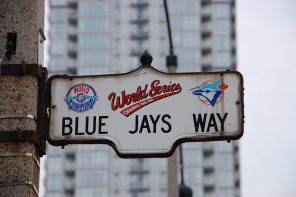It’s rare these days to see the classic cars of the past like a 1957 Chevrolet Bel Air, 1959 Cadillac Eldorado, or a 1964 Ford Mustang cruising down the street. These gems were once average, the car driving too slow when you were late for work. Nowadays, these cars turn heads, prompt photos, and, at the very least, attract a glance up from a phone. The rainbow-colored array of swooping hoods, mirror chrome bumpers, protruding tail fins, and deafening V8 engines seem to have been left in the dust. Today, a sea of sameness traverses the American mall parking lot. Modern vehicles, while efficient and reliable, often evoke a sense of automotive monotony, a visual déjà vu. Tones of grays, whites, and blacks have transformed cars from a transporting art form to a moving blur of forgetfulness. So, what happened to the classic cars of the past?
The rainbow-colored array of swooping hoods, mirror chrome bumpers, protruding tail fins, and deafening V8 engines seem to have been left in the dust.
The answer is simple when boiled down: government regulations. Although the automotive industry has seen changing overarching trends, like the integration of advanced tech, rise of the SUV and crossover, changing family needs, and minimalist design to name a few, government regulations for both safety and emissions have been the primary reason for the demise of stylish and swooping car frames. In the 1970s, the U.S. government implemented regulations requiring larger and more energy-absorbing bumpers. These regulations were aimed at improving safety by reducing the damage caused in low-speed collisions. However, the result was that many cars had bulkier, less aesthetically pleasing front and rear bumpers. The regulations of this era were coined the Malaise Era of automotive styling. Although only lasting until 1983, Malaise Era regulations were carried on into the automobile stagnation witnessed today. Put in place in the 1970s, emission control devices and technologies like catalytic converters often required the installation of visible exhaust components and the raising of vehicle ride height. These changes, while beneficial for the environment, resulted in less attractive car designs and permanent alteration of vehicle aesthetics. Generally, regulations are good: they make cars safer for those who drive in and around them while also protecting our environment from harmful exhaust pollutants. Car companies today, however, are faced with a balancing act: how can cars be stylish, desirable, and cool while also being safe, legal, and eco-friendly? This question is central when looking at the automotive industry of the future. The automotive industry continues to mature and respond to a fast-paced, evolving world. We are nostalgic and envious of the sophisticated classic cars of the past, while living with, and unburdened by, the tolerable automobile production of the present. Regulations have, and will continue to, characterize car design. The question becomes what will be the classic car of the future?
These changes … resulted in less attractive car designs and permanent alteration of vehicle aesthetics.
Predicting the future is a blend of educated guesses and unforeseen surprises. In the 1920s, futurists predicted that the norms of our present would consist of moving walkways, personal helicopters, glass-domed cities, and dream recorders. This is all to say that predicting the classic cars of tomorrow is akin to a goat staring at a wristwatch. But why not try?
A quick google search of “futuristic cars” will reveal a gray, dramatic, and spaceship-like vehicle centered around minimalism and sleek styling. These mockup designs are inching closer to reality, like Elon Musk’s angular and utilitarian design of the Tesla Cybertruck. My thoughts on the car of the future that will one day be the memorable car of the past, goes as follows.
Bring the outside in. The automotive industry is moving rapidly towards fully electric cars as a result of public resolve against climate change and further government regulations leaving internal combustion engines in the past. EV’s are more environmentally friendly, meaning these new cars should bring the outside in through glass. Today, cars have already swapped out front seat sunroofs for panoramic “moonroofs.” Tesla has taken a noticeable lead on this front, the interior roof of many models have ditched any fabric for all glass. Cars today are also larger, allowing for more windows and glass to be used throughout to enhance the feeling of nature within the car.
Automobiles should harken back to the 1950s, 60s, and 70s, when the roadways were bursting in a rainbow of traffic.
Colorization of cars– much like the 1939 Wizard of Oz film ushered in a new modern era of color in the film industry, the automobile industry should experience a new age of colors in cars. Automobiles should harken back to the 1950s, 60s, and 70s, when the roadways were bursting in a rainbow of traffic. Car companies like Mazda, Volvo, and Chevy have already taken the lead in introducing more vibrantly colored cars to the market. What fun is everyday life when it is void of tones and hues?
Other trends that I think will proliferate in the future car market include the resurgence of Wagon styling. Trends of now appoint massive SUV and family cars as triumphant in the car market. However, as urbanization continues, the need for smaller, but highly practical cars will rise. Wagons are sleek and small but boast immense trunk and all weather capabilities. Volvo, BMW, Mercedes, offer wagons in their lineup already. The wagons on the road today, I believe, will already be the classic cars of tomorrow as the bandwagon for wagons starts rolling. Although some may be less eye-catching, there are a few cars, including wagons, that I think will be classic cars sooner rather than later. The Lexus LC 500, classic Ford F-150 , and Land Rover Defender are a few of my picks already owning the road today. These cars are products of either handcrafted detail, societal nostalgia, or a mix of both. Whether riding, driving, or watching, these cars make people feel good.
The automobile industry’s crossroads is not just a problem for sales but a problem for humanity.
These emerging trends represent just a fraction of the many trends expected to unfold in the automotive industry. The automobile industry’s crossroads is not just a problem for sales but a problem for humanity. In today’s world cars are drawn up by computer generation rather than a product of an artform that once was. As it stands, society has lost a sector of imaginative expression that reaches us all. The automotive world may be evolving, but it does not have to do so in a manner detrimental to the creativity of society. The declining designs in the automobile industry can be a lesson to society on automation as a whole. Automation is here to stay, now how do humans cope with it? At our core, humans have simultaneously devoted love to art and beauty as well as innovation and productivity. These ideas should not be mutually exclusive in the conversation of future automation, rather they can blend to produce automation that works for us. Isn’t that the point anyway?
With a new spark of love and authenticity, the industry is poised to recapture the spirit of the past in a thoroughly modern way. The classic cars of tomorrow are set to be a harmonious fusion of eco-friendliness, open interiors, and a burst of lively colors, rekindling the spirit of automotive elegance in a modern context.








